Since you can only get dishwashing detergent in plastic bottles with lots of artificial additives, you should use your Make dishwashing liquid yourself. In addition to the plastic packaging, the dishwashing detergent itself may also contain microplastics. The Palm oilwhich is contained in many dishwashing detergents, we also want to avoid! Today you will therefore get a short tutorial on how you can make your own dishwashing detergent in the future easily and naturally and produce no plastic waste. Besides the production from Baking soda & vegetable soap I have two more alternatives for you to make your own dishwashing liquid.
Make dishwashing liquid yourself - The natural ingredients
While conventional dishwashing detergents contain palm oil or artificial substances for whitening and filling, our plastic-free dishwashing detergent consists of purely sustainable ingredients. To make your own plastic-free dishwashing liquid, you really don't need much. Get these items to make your own dishwashing liquid:
500 - 700 ml container + cooking pot
Of course, you need a container so that your homemade washing-up liquid doesn't run away 😉 To do this, you should either reuse the bottle from your old washing-up liquid or find a suitable glass bottle. In principle, a large jar will also work, but it's best if the opening is not so large. This is the basis for making your own washing-up liquid.
25 g grated vegetable soap
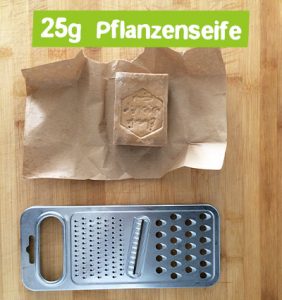
Plant soap is natural without any artificial additives. Ideal to make your own dishwashing liquid. Get the best this aleppo soapIt consists of 60% olive oil and 40% laurel oil. You will need to grate these later for your homemade dishwashing liquid. Get yourself such a plastic free graterif you do not already have them in your kitchen. The plant soap comes completely without palm oil and is not only good to make your own dishwashing liquid, but is also the ideal plastic-free replacement for the handwashing soap from the plastic dispenser. The soap is also made without animal testing, is suitable for all skin types, and is biodegradable. Rubbing the soap takes about 3 minutes.
You can order the Aleppo soap online without plastic here
2 tsp baking soda
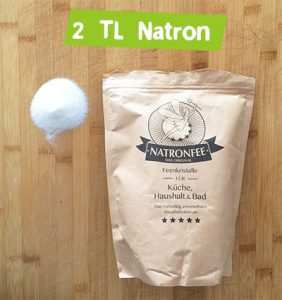
If you want to make your own dishwashing liquid, you should definitely get some baking soda. Since baking soda has a grease-dissolving effect, it's the perfect, plastic-free alternative to chemical ingredients in conventional dishwashing detergents. In addition to using it in your homemade dishwashing detergent, you can also use baking soda as an all-purpose weapon for many other things around the house. You can use baking soda to make your own bath balls, for example, or to remove odors from textiles or even stains from carpets. Just get yourself some more baking soda right away, in the supermarket you usually only get a few grams at overpriced prices.
Here you get soda plastic-free and much cheaper than in the supermarket
5 drops essential oil
Essential oils are natural and give your dishwashing liquid a pleasant scent. However, I must also say that essential oils are not quite as important to make your own dishwashing liquid. The oil simply rounds out your homemade dishwashing liquid and gives you the opportunity to make your dishwashing liquid even more individual.
500 ml water
As the last and very important ingredient to be able to make your own dishwashing liquid, you need about 500 ml of water. I'll show you right now in the step-by-step instructions for your homemade dishwashing detergent, when you can add the ingredients to the water.
That's all you need to make your own natural dishwashing liquid without any artificial additives.
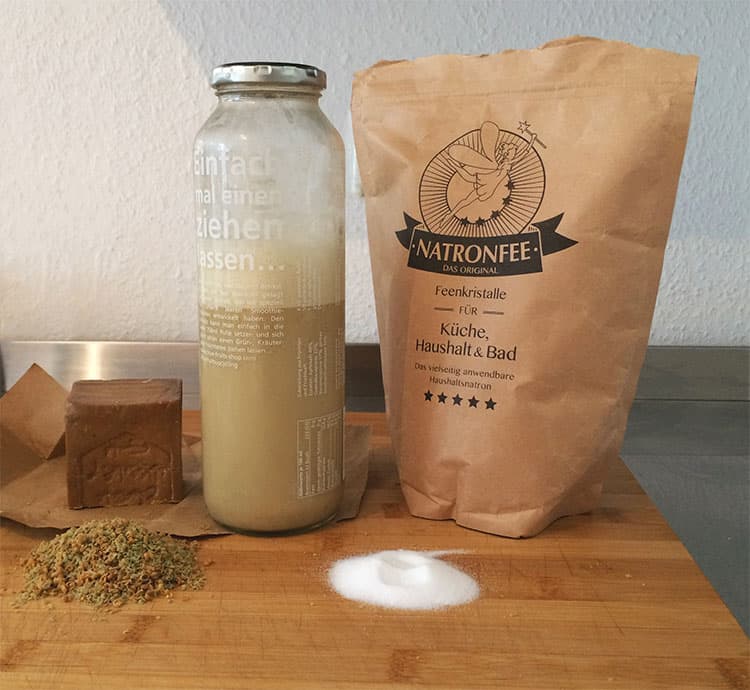
How to make your own plastic-free dishwashing liquid
Now you have all the ingredients you need to make your own dish soap. Grated vegetable soap/leppo soap, baking soda, water, maybe some essential oils, a saucepan and a container for your homemade dishwashing liquid. So now you can make your own dishwashing liquid:
Boil 500 ml of water
When the Aleppo soap is grated and all the other ingredients are ready in the mentioned quantities, you can bring the 500 ml of water to boil in the saucepan. The water is the basis for making the dishwashing liquid yourself.
Add 25 g grated vegetable soap
From now on, you can add all the ingredients for your homemade dishwashing liquid to the boiling water. First, add the 25 g of Aleppo soap to the pot.
Add 5 drops of essential oil
If you like, you can now also add the 5 drops of your essential oil. The oil gives your homemade dishwashing liquid a cool scent, which you can vary as desired. However, the essential oil is not a must to make your own dishwashing liquid.
Add 2 tsp. baking soda
Now it's time to add 2 tsp of baking soda to the boiling water. Baking soda dissolves grease and cleans and is a great plastic-free, natural alternative to chemical dishwashing detergent. Two teaspoons of baking soda is all you need.
Stir rinsing agent well
Now you can stir your homemade dishwashing liquid well and boil it for another 1 minute on low heat. The combination of baking soda and vegetable soap is ideal for your own dishwashing liquid.
Fill the detergent and shake vigorously
Fill your homemade dishwashing liquid now into your container, from which you will then always use it in the future. If possible, of course & plastic-free. Alternatively, you can reuse the old container. Once the lid is on, you should shake your detergent vigorously. If you did everything right, your homemade dishwashing liquid will now foam.
Dishwashing detergent make yourself - It washes differently!
The dishwashing detergent that you have now made yourself is somewhat different in use than the chemical dishwashing detergent from the plastic packaging, but just as uncomplicated. You have to use a little more of the homemade washing-up liquid, as we have not used any aggressive, chemical ingredients for the production. Leave the plastic-free detergent on for a few minutes longer than with conventional detergent. For stubborn layers of grease, you can then add a little more detergent.
Dishwashing liquid make yourself with ivy
Another alternative to make your own dishwashing liquid is ivy! Ivy contains so-called saponins, which make the plant ideal for a homemade dishwashing liquid. Ivy grows everywhere and especially on tree trunks and house walls. You can get the leaves all year round, as they are permanently green. You can't get more natural than that.
How to make your own dishwashing liquid with ivy:
- Fill crushed ivy leaves (about 20 leaves) in a saucepan with 500 ml of boiling water.
- After 5 minutes on high temperature, you can turn off the stove.
- Once the liquid is cooler, you can pour it into a 500 - 700 ml jar. As with homemade detergent from chestnuts, this composition now needs a little time.
- After about 5 hours, you can simply shake the detergent once vigorously. I was also surprised, but now it should foam!
- TIP: From ivy, by the way, you can also make your Make detergent yourself!
If the jar is not the ideal solution, you should now pour your homemade dishwashing liquid from ivy into a container that is better for you. You can now use it to wash your dishes naturally by hand. If you want to use it for the dishwasher, you should add washing soda. Put the detergent in the refrigerator so that it lasts as long as possible.
Dishwashing liquid make yourself with lemons
Also from lemons you can wonderfully make your own dishwashing liquid and use it especially in the dishwasher. From lemons I have not yet made my own dishwashing liquid, but for this I found a perfect video of a nice lady. She has used the following ingredients for her homemade dishwashing liquid from lemons:
- 3 organic lemons
- 100 ml organic apple cider vinegar
- 200 gram table salt
- 400 ml water
Plus 2 canning jars for storage. That is already everything. Simply quarter the lemons and put them in the blender. After they are pureed, add the 200 g of salt and mix again. Then put the mixture in a saucepan with the water and the apple cider vinegar. Now you can bring the pot to a boil and wait about 5 - 10 minutes. Afterwards, sieve the whole thing again so that you only have the natural dishwashing liquid. Pour the detergent into your containers and your homemade lemon dishwashing liquid is ready. It does not foam, but makes the glasses really nice clean. Natural and plastic-free. If you want to know more, be sure to check out the nice video tutorial below:
Make dishwashing liquid yourself - Really easy, isn't it?
Were you able to make your own dishwashing liquid? Did it foam? Just write me in the comments. Why do we always have to buy everything when we can make many things ourselves naturally & plastic-free? The Zero Waste Lifestyle makes everything more natural and simple. I hope you're happy with your own homemade dishwashing liquid.
Do you have any suggestions for improvement or better ingredients to make dishwashing liquid yourself? Then just write me in the comments.
Stay clean,

PS: Learn in the Do It Yourself Blog for example also how you Make toothpaste yourself can!


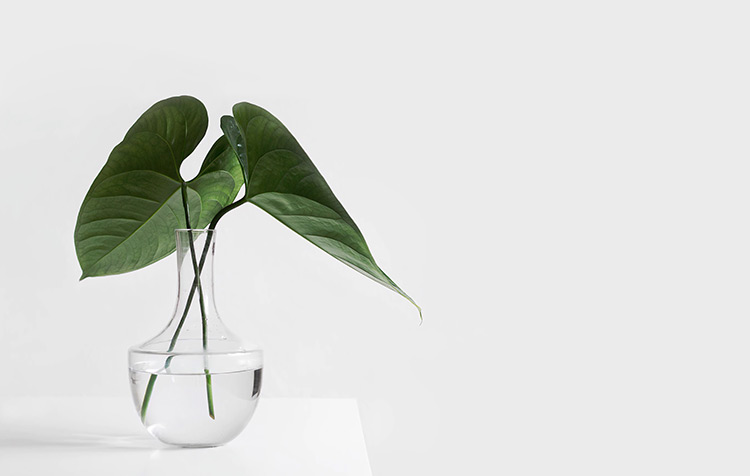
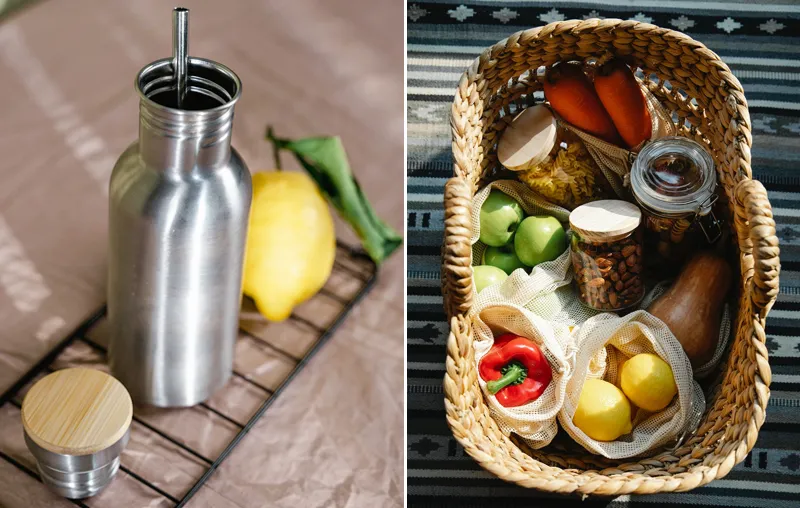

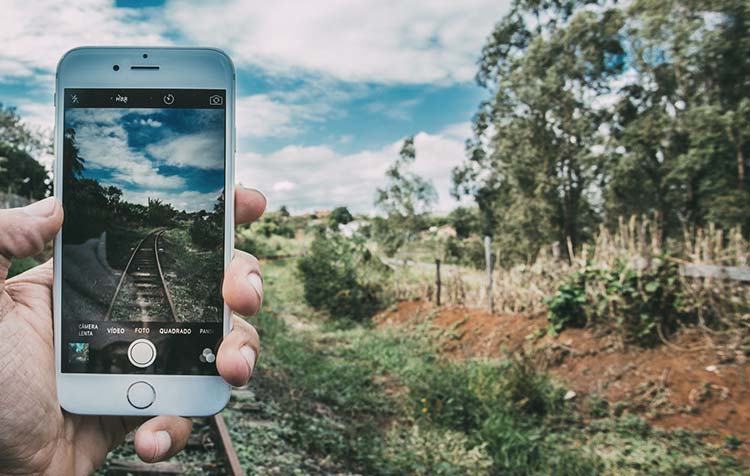
Is there any use-by date until when you can use or should dispose of the dishwashing liquid?
Hi Max! Basically it lasts a few weeks. But it's best to go by feel and use your senses 😉
Best regards
Christoph
Hello,
how is it with soap residue? I know what my sink looks like after two days if I just use my hand soap. Won't the dishes get sticky with the soap dishwashing liquid?
Greeting Barbara
Hey Barbara! No residue - and sticky is also nothing. At least that's my experience with the homemade dishwashing liquid.
Just give it a try - you can otherwise also choose from Ivy dishwashing liquid make yourself.
Best regards
Christoph
Hello Christoph,
great post - thank you!!!
I use the dishwashing liquid with plant soap according to your instructions already a few months and it works wonderfully!!! The soap is a plant soap with mint scent - so I already save the fragrance oil. ?
(From Aleppo soap I make detergent..... )
LG, Sabine
Hey Sabine! I'm so glad that you like the dishwashing liquid! Thanks for the inspiration with the mint scent!
Best regards,
Christoph
Hello, a great report. Freu we have enough here 😉
But how long is the shelf life of homemade dishwashing detergent ?
Would be very interested ..... Thanks .
Greetings, Sabine
Hi Sabine! So with us it holds itself in any case already for 4 weeks.
LG Christoph
I also make my own dishwashing liquid and am totally satisfied with the result. Only that with the ivy leaves I have never done, My next dishwashing liquid production will be with ivy. I am glad that such great tips are passed on.
Many environmental love greetings
Monika
Hi Monika! Very good, us too! 🙂
Hope you found a good ivy spot near you! Have fun with the Ivy Rinse and best regards,
Christoph
Hello Christoph,
thank you very much for these interesting suggestions.
How small should you cut the ivy leaves, and should you leave them in or sift them out when bottling?
Thank you, greeting,
Julian
Hi Julian! Relatively small, but you do not have to overdo it. You boil them briefly in water and pour everything through a sieve into the bottle, so that the leaves remain outside.
Best regards
Christoph
Hi Christoph, I tried the soap with soda recipe yesterday and it solidified after cooling. Can you help me there? Do you have an idea what I could have done wrong and maybe how I get it now subsequently liquid?
Thank you!!!
Hi Dina! To be honest, I can't explain it, did you perhaps use too little water? For me, this washing-up liquid is always liquid - unless you put it in the freezer 😉
Many greetings,
Christoph
Hello
The dishwashing detergent with Aleppo soap etc. has failed with me, despite all the willingness to compromise as far as the type of rinsing is concerned. Everything is always greasy, including the sink, dishcloth and brush. In addition, the high gas and water consumption. Aaaaabut the lemon dishwashing liquid below, after the ivy dishwashing liquid, is the hammer ?. I make three tablespoons of it in the water since I have a slightly larger sink. There is nothing too much promised and I can rinse as usual. Only one question about it: how long is it durable?
LG Gritt
Hi Gritt! Thank you for your feedback! The lemon dishwashing liquid best to use up in about 2 weeks. We have now made our own dishwashing liquid from ivy - it lasts forever and works perfectly. I'm still finishing up an article on that.
Many greetings
Christoph
Hello Christoph
Thank you for your answer. Will then try the ivy rinse in any case also. It's really fun when you can make something yourself and then it works. Detergent I've been doing for a while and I'm thrilled. ?
LG Gritt
Hi Gritt! Great, that makes me happy! In any case, you always learn something new 🙂
Continue to have fun and stay clean,
Christoph
Hello,
have only crushed pieces of Aleppo put in a dishwashing liquid bottle and filled with warm water. I shook it and gradually it dissolves completely.
I
Hi Chuan,
super,'s also so works wonderfully as a rinse aid? Then thank you for the tip!
Best regards
Christoph
Can you possibly freeze the dishwashing liquid from ivy, or does it then lose its effect?
Greetings and thank you for your feedback.
Monique
Hi Monique! Ivy grows super fast and can really be found on every corner 🙂 So you don't necessarily have to freeze it.If you do, make sure that 1/4 of your container remains unfilled, as the washing-up liquid expands when frozen and could otherwise cause the jar to burst.
In the article Freeze plastic-free you can learn more about it.
Stay clean,
Christoph
Hello, I find the ingredients totally overpriced (12,- and 9,- for Aleppo soap and soda) Hello? A bottle of dishwashing liquid from eg Ecover or Sonett costs 2-3 euros. Find the mistake! In addition, the cleaning effect leaves much to be desired. The glasses have a greasy film and everything is not properly clean.
Hi Jana, you can use the soap at least 10 times for your homemade washing-up liquid - so in the end it's cheaper, doesn't create any plastic waste and is also natural and free from any chemical additives. Works perfectly for us 🙂
Many greetings
Christoph
Hello Jana,
Try adding a dash of vinegar (surig) to the rinse water when you rinse glasses. I have the soap / soda variant and am actually satisfied. The fat-cleaning power is just andersst than the conventional, but the residues are natural and not from the chemiekasten ...
Greeting
Jochen
Moin moin,
I made the dishwashing liquid from ivy and am totally happy with it. Thank you for sharing all the ideas, I will try them all little by little.
This reminds me a lot of my teenage years in Brazil, when it was normal to work with natural resources. I even did lively exchanges, our oranges for eggs, for example.
Now I am obviously no longer a freak with my views.
All the best
Ines
Hi Ines! Haha, very nicely described 🙂 Great that everything works out!
Many greetings
Christoph
I would like to try the ivy dishwashing liquid. Ivy is actually toxic, isn't that a problem with washing dinnerware? What do you know about it?
VG
Michaela
Hi Michaela!
I just did a little research. There are two forms of ivy:
- Ground cover ivy and juvenile form of Hedera helix tend not to be toxic
- Fruiting age form Hedera helix 'Arbonrescens' are poisonous
But you don't have to worry about using it for dishwashing liquid. Just like conventional dishwashing liquid, it should simply not be drunk or get into your eyes.
Many greetings,
Christoph
Hi there... I'm really looking forward to trying out an alternative to store-bought washing-up liquid. Unfortunately, my washing-up liquid has solidified after cooling 🙁
Greetings Julia
Hey Julia 🙂
Oh, what ingredients did you use? Otherwise, like to try it with ivy!
Stay clean,
Christoph
Is supposed to become solid, lt video, and then you should take 2 spoonfuls (tablespoon or teaspoon ?? is not said) for the dishwasher. But I have read out here that it does not work and does not eliminate the fat in pans, pots and plates.
Hi Carmen! You probably mean the lemons, right? I haven't tried the washing-up liquid with lemons myself. I have one made from ivy. The specifications should all fit there too 🙂
Many greetings,
Christoph
Have me there some time ago also tried it but it's probably gone thoroughly in the pants, but since I find that generally very interesting to make his things if possible, I'll try it again with your tips.
Thank you and keep up the good work
Moin Jan,
Where exactly did it fail? 🙂 Try ivy, it's super easy!
Many greetings,
Christoph
That all sounds very interesting, I'll get some things and start mixing 🙂
Great Melli, have fun trying it out! 🙂
Stay clean,
Christoph
First of all, thank you for your work and effort. I am also looking for an alternative to washing-up liquid as I and my skin don't tolerate it so well and I find washing up with gloves a bit strange 😀
Can you give me a hint on that?
Hi Sascha, everything is in the article 😉
I recommend you the dishwashing detergent made from ivy leaves. Works perfectly.
Stay clean,
Christoph
Oh that sounds really all very interesting and I think I'll try to brew myself what together
Hi Chrissi,
definitely do that! I recommend the ivy version. It's really easy 😉
Stay clean,
Christoph
Wow these are mega cool ideas. finally I no longer have to buy and can save and help the environment. Class I'm glad that you make the effort to share something with us. Thank you and keep it up.
Love greetings Anja
Hello Anja,
Thank you for your feedback! Have fun with your own washing-up liquid 🙂
Love greetings
Christoph
1. note: as the name suggests, essential oils volatilize quickly - it is a waste to add them to the hot liquid, then also continue boiling, etc. - after making such homemade remedy, you can add a few drops to the bottle, after cooling. Everything else is nonsense.
2. I have already tried a few recipes for homemade dishwashing detergent - none of them had even a remotely satisfactory cleaning effect, and for the insufficient cleaning effect you also had to add vast quantities to the dishwater. That a few drops of essential oil could have left a greasy film on pots and pans, that's absurd. The formula simply does not clean, even glasses do not get clean.
It's a shame, but the thing is, you can't just make a substitute for commercial dishwashing liquid yourself. I wish it were different. It would be good if there was something like "solid dishwashing detergent", then you wouldn't have any plastic waste.
Hi THP, I always make my own washing-up liquid from ivy now and it's both easy to make and has good cleaning power. I have absolutely no problems with it 🙂 Have you tried it yet?
Best regards,
Christoph
Hello THP,
there is definitely solid dishwashing detergent... google solid dish wash....
this is then a solid block (depending on the casting mold) and you simply rub the dishcloth or the dishwashing brush over it, thereby creating foam. In principle, like shaving brush and shaving soap.....
LG, Sabine
Hello Christoph,
I forgot to mention that, I did not use essential oils at all. I have put the rinsing agent with alepine soap, can that be wrong?
Vg Christine
I have made myself some time ago the dishwashing liquid with sodium bicarbonate. However, I am not completely satisfied with the Spülgebniss. My stainless steel pots always have a greasy layer and even the greasy pan is still greasy after rinsing. What could I have done wrong? Vg
Hi Christine, sorry for my late reply. So oily and greasy... it sounds like you added too many drops of the essential oil. I left it out completely because it's just about the smell. Try again without the oil 🙂 The other ingredients in the homemade washing up liquid can't really be the cause.
I hope I was able to help you 🙂
With best regards
Christoph
If you want to make the dishwashing liquid from ivy:
How many ivy leaves do you have to take? Unfortunately, this is not clear from the instructions...
Hi Andreas! Simply use about 20 ivy leaves to make your own washing-up liquid 🙂 You can also use ivy to make your own Make detergent yourself. Since you can alternatively put the sheets in a close-meshed net and put directly into the laundry drum. This is also possible.
Best regards,
Christoph
Hello,
do you really have long-term experience washing with ivy?
I did this for about half a year and the laundry started to smell musty. After I use other products again, the smell is gone again.
I had added essential oils to it.
How is it with you?
Best regards,
Monika
Hi Monika! I currently use the Ivy dishwashing liquid only for my dishes - so for the quick rinse in the sink.
There it works perfectly and also solves fat.
Best regards
Christoph